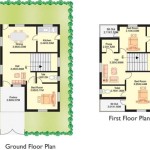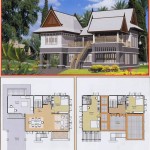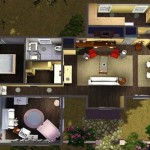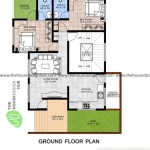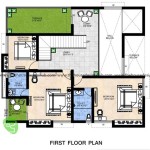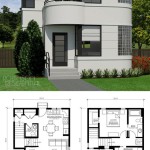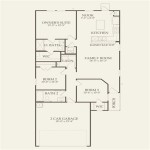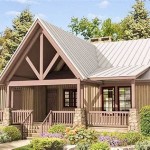Plan Of A Roman Villa
The Roman villa, more than just a rural dwelling, represents a complex tapestry of social, economic, and architectural ideas woven together. Examining the plan of a Roman villa offers profound insights into the lives of its inhabitants, their priorities, and the agricultural system that underpinned Roman society. These structures, varying greatly in size and complexity, served not only as residences but also as centers of agricultural production and symbols of wealth and status. Understanding the key components of a Roman villa plan provides a window into the sophisticated world of the Roman elite and the workers who supported their lifestyle.
The term "villa" itself encompassed a wide range of structures. A small farmhouse occupied by a tenant farmer differed dramatically from a sprawling estate owned by a wealthy senator. However, certain features remained relatively consistent across different types of villas. These elements reflect the dual function of the villa as both a domestic space and a center for agricultural activities. Analyzing the layout of these spaces reveals the interconnectedness of these functions and the careful planning that went into creating a functional and aesthetically pleasing environment.
Archaeological excavations throughout the Roman Empire, from Italy to Britain, have unearthed numerous villas, providing a wealth of information about their construction and layout. These discoveries, coupled with literary sources such as the writings of Pliny the Elder and Columella, provide a comprehensive, albeit sometimes incomplete, picture of the Roman villa and its significance. By studying these sources, it is possible to reconstruct the typical plan of a Roman villa and understand the purpose of its various components.
Key Point 1: The Pars Urbana - The Residential Zone
The *pars urbana*, or residential zone, was the heart of the villa, designed for comfort, leisure, and display. This section was typically decorated with elaborate mosaics, frescoes, and sculptures, reflecting the owner's wealth and artistic taste. The layout of the *pars urbana* often mirrored the design of urban Roman houses, adapted to the rural setting. The placement of rooms was carefully considered to maximize natural light and ventilation, as well as to provide stunning views of the surrounding countryside.
At the core of the *pars urbana* often lay the *atrium*, an open courtyard that served as a central reception area. In grander villas, this space might feature a *compluvium*, an opening in the roof that allowed rainwater to collect in a *impluvium*, a shallow basin below. This water was then channeled into a cistern for later use. Surrounding the *atrium* were various rooms including *cubicula* (bedrooms), *triclinia* (dining rooms), and *tablina* (studies or offices). These rooms were often arranged around a *peristyle*, a colonnaded courtyard that provided a tranquil and aesthetically pleasing space for relaxation.
The *triclinium*, or dining room, was a particularly important space in the *pars urbana*. Romans typically reclined on couches while dining, and the *triclinium* was designed to accommodate these couches in a specific arrangement, allowing for social interaction and conversation. The room was often decorated with elaborate mosaics and frescoes, reflecting the importance of dining as a social event. The size and opulence of the *triclinium* served as a statement of the owner's wealth and status.
Another key element of the *pars urbana* was the bath complex, or *balneum*. Roman bathing was a social and hygienic ritual, and the bath complex was an essential feature of any self-respecting villa. The *balneum* typically consisted of several rooms, including the *apodyterium* (changing room), the *frigidarium* (cold room), the *tepidarium* (warm room), and the *caldarium* (hot room). A hypocaust system, an underfloor heating system, provided warmth to the *tepidarium* and *caldarium*. The *balneum* was not only a place for bathing but also a space for socializing and conducting business.
The presence of gardens was another vital component of the *pars urbana*. Gardens provided a visual extension of the living space, connecting the interior with the surrounding landscape. These gardens were often meticulously planned and featured fountains, sculptures, and a variety of plants and flowers. The gardens served as a place for relaxation, contemplation, and entertainment. They often mirrored the formal gardens of urban Roman houses, adapted to the larger scale of the villa.
Key Point 2: The Pars Rustica - The Agricultural Zone
The *pars rustica*, or agricultural zone, was the functional heart of the villa, responsible for the production of crops, livestock, and other agricultural goods. This section was typically located away from the *pars urbana* to minimize disruption to the living quarters. The layout of the *pars rustica* was dictated by the type of agricultural activities carried out at the villa, with different areas dedicated to specific tasks.
Essential features of the *pars rustica* included storage areas for grain, wine, and oil. These storage facilities, such as *horrea* (granaries) and *cellae vinariae* (wine cellars), were designed to protect the harvested goods from the elements and pests. The size and number of these storage areas reflected the scale of agricultural production at the villa. The *pars rustica* also included stables for livestock, workshops for crafting tools and equipment, and housing for slaves and agricultural workers.
The *torcularium*, the wine and olive pressing room, was a central component of villas that produced wine and olive oil. This room housed the heavy machinery needed to extract the juice from grapes and olives. The *torcularium* was often a large and well-ventilated space, designed to accommodate the labor-intensive process of pressing. The placement of the *torcularium* was carefully considered to facilitate the movement of raw materials and finished products.
The location of the *pars rustica* was often determined by the availability of water sources and fertile land. Villas were typically situated near rivers, springs, or wells to ensure a reliable supply of water for irrigation and other agricultural activities. The surrounding land was carefully cultivated to maximize crop yields. The *pars rustica* was not merely a collection of functional buildings; it was a meticulously planned agricultural complex designed to support the economic viability of the villa.
The workforce in the *pars rustica* consisted primarily of slaves, but free laborers might also be employed, especially during harvest seasons. The living conditions for these workers were often harsh, with simple accommodations and long hours of labor. The management of the *pars rustica* was typically overseen by a *villicus*, a slave or freedman responsible for supervising the agricultural operations and ensuring the efficient operation of the estate.
Key Point 3: The Pars Fructuaria - The Processing and Storage Zone
While often considered part of the *pars rustica*, the *pars fructuaria* deserves specific attention. This section focused on the processing and storage of the agricultural products generated by the villa's farmland. It was the link between harvesting and eventual consumption or sale, therefore demanding specialized features for efficient operation.
Key elements of the *pars fructuaria* included areas for drying fruit, grains, and other crops. Large, open spaces, often paved and exposed to the sun, allowed for the efficient drying of harvested goods. These areas were often located near storage facilities to minimize the distance required to transport the dried products. Careful attention was given to ventilation to prevent mold and spoilage.
The *cella vinaria*, or wine cellar, played a crucial role in the *pars fructuaria*. The proper storage of wine was essential to prevent spoilage and maintain its quality. Wine cellars were typically located underground to provide a cool and stable temperature. Amphorae, large ceramic jars, were used to store and transport wine. The layout of the *cella vinaria* was designed to facilitate the handling and storage of these amphorae.
The production of olive oil also required specialized facilities in the *pars fructuaria*. Olive mills, consisting of large stone mortars and pestles, were used to crush the olives and extract the oil. The oil was then separated from the water and impurities using settling tanks. The resulting olive oil was stored in amphorae and transported for consumption or sale. The cleanliness and hygiene of the olive oil production process were critical to ensuring the quality of the final product.
The *pars fructuaria* was not just a collection of storage rooms; it was an integrated system for processing and preserving agricultural products. The efficiency of this system was essential to the economic success of the Roman villa. The layout and design of the *pars fructuaria* reflected the sophisticated understanding of agricultural techniques and storage methods that characterized Roman agriculture.
In conclusion, the plan of a Roman villa was a complex and multifaceted reflection of Roman society, economy, and culture. The division into the *pars urbana*, *pars rustica*, and *pars fructuaria* highlights the dual function of the villa as both a residence and a center for agricultural production. By studying the layout and design of these different sections, it is possible to gain a deeper understanding of the lives of the people who lived and worked in these remarkable structures. The Roman villa stands as a testament to the ingenuity and organizational skills of the Roman Empire.

Smarthistory Roman Domestic Architecture The Domus

The Roman Domus House Architecture And Reconstruction

Roman Houses And Villas

Ancient Roman Villa Floor Plan
Plan And Elevation Of A Roman Villa Nypl Digital Collections

Plan Of A Pompeian House

Seeking Floor Plan Of A Classical Roman Building With 20 To 30 Rooms History Stack Exchange

Learning About The Roman House For Love Of Rome

Roman House

The Roman Villa Role In Ancient History 534 Words Essay Example

